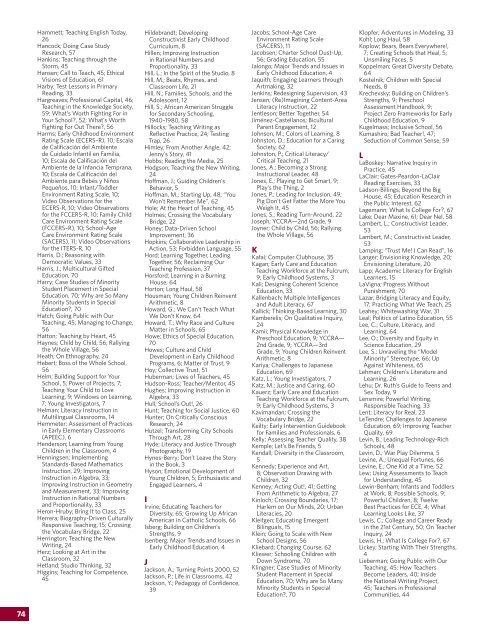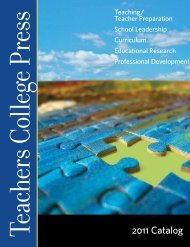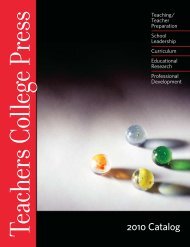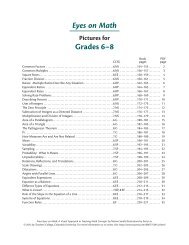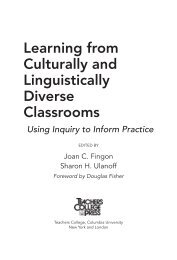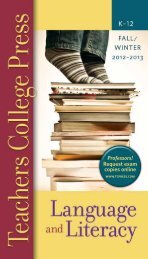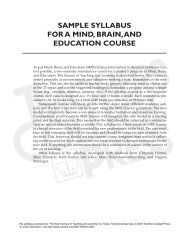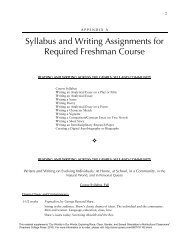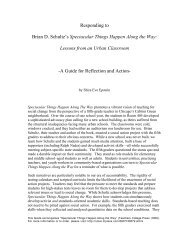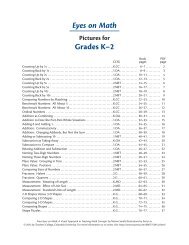estsellers - Teachers College Press
estsellers - Teachers College Press
estsellers - Teachers College Press
You also want an ePaper? Increase the reach of your titles
YUMPU automatically turns print PDFs into web optimized ePapers that Google loves.
Hammett; Teaching English Today,<br />
26<br />
Hancock; Doing Case Study<br />
Research, 57<br />
Hankins; Teaching through the<br />
Storm, 45<br />
Hansen; Call to Teach, 45; Ethical<br />
Visions of Education, 61<br />
Harby; Test Lessons in Primary<br />
Reading, 33<br />
Hargreaves; Professional Capital, 46;<br />
Teaching in the Knowledge Society,<br />
59; What’s Worth Fighting For in<br />
Your School, 52; What’s Worth<br />
Fighting For Out There, 56<br />
Harms; Early Childhood Environment<br />
Rating Scale (ECERS–R), 10; Escala<br />
de Calificación del Ambiente<br />
de Cuidado Infantil en Familia,<br />
10; Escala de Calificación del<br />
Ambiente de la Infancia Temprana,<br />
10; Escala de Calificación del<br />
Ambiente para Bebés y Niños<br />
Pequeños, 10; Infant/Toddler<br />
Environment Rating Scale, 10;<br />
Video Observations for the<br />
ECERS-R, 10; Video Observations<br />
for the FCCERS-R, 10; Family Child<br />
Care Environment Rating Scale<br />
(FCCERS–R), 10; School-Age<br />
Care Environment Rating Scale<br />
(SACERS), 11; Video Observations<br />
for the ITERS-R, 10<br />
Harris, D.; Reasoning with<br />
Democratic Values, 33<br />
Harris, J.; Multicultural Gifted<br />
Education, 70<br />
Harry; Case Studies of Minority<br />
Student Placement in Special<br />
Education, 70; Why are So Many<br />
Minority Students in Special<br />
Education, 70<br />
Hatch; Going Public with Our<br />
Teaching, 45; Managing to Change,<br />
56<br />
Hatton; Teaching by Heart, 45<br />
Haynes; Child by Child, 56; Rallying<br />
the Whole Village, 56<br />
Heath; On Ethnography, 24<br />
Hebert; Boss of the Whole School,<br />
56<br />
Helm; Building Support for Your<br />
School, 5; Power of Projects, 7;<br />
Teaching Your Child to Love<br />
Learning, 9; Windows on Learning,<br />
7; Young Investigators, 7<br />
Helman; Literacy Instruction in<br />
Multilingual Classrooms, 14<br />
Hemmeter; Assessment of Practices<br />
in Early Elementary Classrooms<br />
(APEEC), 6<br />
Henderson; Learning from Young<br />
Children in the Classroom, 4<br />
Henningsen; Implementing<br />
Standards-Based Mathematics<br />
Instruction, 29; Improving<br />
Instruction in Algebra, 33;<br />
Improving Instruction in Geometry<br />
and Measurement, 33; Improving<br />
Instruction in Rational Numbers<br />
and Proportionality, 33<br />
Heron-Hruby; Bring It to Class, 25<br />
Herrera; Biography-Driven Culturally<br />
Responsive Teaching, 15; Crossing<br />
the Vocabulary Bridge, 22<br />
Herrington; Teaching the New<br />
Writing, 24<br />
Herz; Looking at Art in the<br />
Classroom, 32<br />
Hetland; Studio Thinking, 32<br />
Higgins; Teaching for Competence,<br />
45<br />
Hildebrandt; Developing<br />
Constructivist Early Childhood<br />
Curriculum, 8<br />
Hillen; Improving Instruction<br />
in Rational Numbers and<br />
Proportionality, 33<br />
Hill, L.; In the Spirit of the Studio, 8<br />
Hill, M.; Beats, Rhymes, and<br />
Classroom Life, 21<br />
Hill, N.; Families, Schools, and the<br />
Adolescent, 12<br />
Hill, S.; African American Struggle<br />
for Secondary Schooling,<br />
1940–1980, 58<br />
Hillocks; Teaching Writing as<br />
Reflective Practice, 24; Testing<br />
Trap, 26<br />
Himley; From Another Angle, 42;<br />
Jenny’s Story, 41<br />
Hobbs; Reading the Media, 25<br />
Hodgson; Teaching the New Writing,<br />
24<br />
Hoffman, J.; Guiding Children’s<br />
Behavior, 5<br />
Hoffman, M.; Starting Up, 48; “You<br />
Won’t Remember Me”, 62<br />
Hole; At the Heart of Teaching, 45<br />
Holmes; Crossing the Vocabulary<br />
Bridge, 22<br />
Honey; Data-Driven School<br />
Improvement, 36<br />
Hopkins; Collaborative Leadership in<br />
Action, 53; Forbidden Language, 55<br />
Hord; Learning Together, Leading<br />
Together, 56; Reclaiming Our<br />
Teaching Profession, 37<br />
Horsford; Learning in a Burning<br />
House, 64<br />
Horton; Long Haul, 58<br />
Housman; Young Children Reinvent<br />
Arithmetic, 8<br />
Howard, G.; We Can’t Teach What<br />
We Don’t Know, 64<br />
Howard, T.; Why Race and Culture<br />
Matter in Schools, 65<br />
Howe; Ethics of Special Education,<br />
70<br />
Howes; Culture and Child<br />
Development in Early Childhood<br />
Programs, 6; Matter of Trust, 9<br />
Hoy; Collective Trust, 51<br />
Huberman; Lives of <strong>Teachers</strong>, 45<br />
Hudson-Ross; Teacher/Mentor, 45<br />
Hughes; Improving Instruction in<br />
Algebra, 33<br />
Hull; School’s Out!, 26<br />
Hunt; Teaching for Social Justice, 60<br />
Hunter; On Critically Conscious<br />
Research, 24<br />
Hutzel; Transforming City Schools<br />
Through Art, 28<br />
Hyde; Literacy and Justice Through<br />
Photography, 19<br />
Hynes-Berry; Don’t Leave the Story<br />
in the Book, 3<br />
Hyson; Emotional Development of<br />
Young Children, 5; Enthusiastic and<br />
Engaged Learners, 4<br />
I<br />
Irvine; Educating <strong>Teachers</strong> for<br />
Diversity, 65; Growing Up African<br />
American in Catholic Schools, 66<br />
Isberg; Building on Children’s<br />
Strengths, 9<br />
Isenberg; Major Trends and Issues in<br />
Early Childhood Education, 4<br />
J<br />
Jackson, A.; Turning Points 2000, 52<br />
Jackson, P.; Life in Classrooms, 42<br />
Jackson, Y.; Pedagogy of Confidence,<br />
39<br />
Jacobs; School-Age Care<br />
Environment Rating Scale<br />
(SACERS), 11<br />
Jacobsen; Charter School Dust-Up,<br />
56; Grading Education, 55<br />
Jalongo; Major Trends and Issues in<br />
Early Childhood Education, 4<br />
Jaquith; Engaging Learners through<br />
Artmaking, 32<br />
Jenkins; Redesigning Supervision, 43<br />
Jensen; (Re)Imagining Content-Area<br />
Literacy Instruction, 22<br />
Jentleson; Better Together, 54<br />
Jiménez-Castellanos; Bicultural<br />
Parent Engagement, 12<br />
Johnson, M.; Colors of Learning, 8<br />
Johnston, D.; Education for a Caring<br />
Society, 62<br />
Johnston, P.; Critical Literacy/<br />
Critical Teaching, 21<br />
Jones, A.; Becoming a Strong<br />
Instructional Leader, 48<br />
Jones, E.; Playing to Get Smart, 9;<br />
Play’s the Thing, 2<br />
Jones, P.; Leading for Inclusion, 49;<br />
Pig Don’t Get Fatter the More You<br />
Weigh It, 45<br />
Jones, S.; Reading Turn-Around, 22<br />
Joseph; YCCRA—2nd Grade, 9<br />
Joyner; Child by Child, 56; Rallying<br />
the Whole Village, 56<br />
K<br />
Kafai; Computer Clubhouse, 35<br />
Kagan; Early Care and Education<br />
Teaching Workforce at the Fulcrum,<br />
9; Early Childhood Systems, 3<br />
Kali; Designing Coherent Science<br />
Education, 33<br />
Kallenbach; Multiple Intelligences<br />
and Adult Literacy, 67<br />
Kallick; Thinking-Based Learning, 30<br />
Kamberelis; On Qualitative Inquiry,<br />
24<br />
Kamii; Physical Knowledge in<br />
Preschool Education, 9; YCCRA—<br />
2nd Grade, 9; YCCRA—3rd<br />
Grade, 9; Young Children Reinvent<br />
Arithmetic, 8<br />
Kariya; Challenges to Japanese<br />
Education, 69<br />
Katz, L.; Young Investigators, 7<br />
Katz, M.; Justice and Caring, 60<br />
Kauerz; Early Care and Education<br />
Teaching Workforce at the Fulcrum,<br />
9; Early Childhood Systems, 3<br />
Kavimandan; Crossing the<br />
Vocabulary Bridge, 22<br />
Keilty; Early Intervention Guidebook<br />
for Families and Professionals, 6<br />
Kelly; Assessing Teacher Quality, 38<br />
Kemple; Let’s Be Friends, 5<br />
Kendall; Diversity in the Classroom,<br />
5<br />
Kennedy; Experience and Art,<br />
8; Observation Drawing with<br />
Children, 32<br />
Kenney; Acting Out!, 41; Getting<br />
From Arithmetic to Algebra, 27<br />
Kinloch; Crossing Boundaries, 17;<br />
Harlem on Our Minds, 20; Urban<br />
Literacies, 20<br />
Kleifgen; Educating Emergent<br />
Bilinguals, 15<br />
Klein; Going to Scale with New<br />
School Designs, 56<br />
Kliebard; Changing Course, 62<br />
Kliewer; Schooling Children with<br />
Down Syndrome, 70<br />
Klingner; Case Studies of Minority<br />
Student Placement in Special<br />
Education, 70; Why are So Many<br />
Minority Students in Special<br />
Education, 70<br />
Klopfer; Adventures in Modeling, 33<br />
Kohl; Long Haul, 58<br />
Koplow; Bears, Bears Everywhere!,<br />
7; Creating Schools that Heal, 5;<br />
Unsmiling Faces, 5<br />
Koppelman; Great Diversity Debate,<br />
64<br />
Kostelnik; Children with Special<br />
Needs, 8<br />
Krechevsky; Building on Children’s<br />
Strengths, 9; Preschool<br />
Assessment Handbook, 9;<br />
Project Zero Frameworks for Early<br />
Childhood Education, 9<br />
Kugelmass; Inclusive School, 56<br />
Kumashiro; Bad Teacher!, 47;<br />
Seduction of Common Sense, 59<br />
L<br />
LaBoskey; Narrative Inquiry in<br />
Practice, 45<br />
LaClair; Gates-Peardon-LaClair<br />
Reading Exercises, 33<br />
Ladson-Billings; Beyond the Big<br />
House, 45; Education Research in<br />
the Public Interest, 62<br />
Lagemann; What Is <strong>College</strong> For, 67<br />
Lake; Dear Maxine, 61; Dear Nel, 58<br />
Lambert, L.; Constructivist Leader,<br />
53<br />
Lambert, M.; Constructivist Leader,<br />
53<br />
Lamping; “Trust Me! I Can Read”, 16<br />
Langer; Envisioning Knowledge, 20;<br />
Envisioning Literature, 20<br />
Lapp; Academic Literacy for English<br />
Learners, 15<br />
LaVigna; Progress Without<br />
Punishment, 70<br />
Lazar; Bridging Literacy and Equity,<br />
17; Practicing What We Teach, 25<br />
Leahey; Whitewashing War, 31<br />
Leal; Politics of Latino Education, 55<br />
Lee, C.; Culture, Literacy, and<br />
Learning, 64<br />
Lee, O.; Diversity and Equity in<br />
Science Education, 29<br />
Lee, S.; Unraveling the “Model<br />
Minority” Stereotype, 66; Up<br />
Against Whiteness, 65<br />
Lehman; Children’s Literature and<br />
Learning, 26<br />
Lehu; Dr. Ruth’s Guide to Teens and<br />
Sex Today, 9<br />
Lensmire; Powerful Writing,<br />
Responsible Teaching, 33<br />
Lent; Literacy for Real, 23<br />
LeTendre; Challenges to Japanese<br />
Education, 69; Improving Teacher<br />
Quality, 69<br />
Levin, B.; Leading Technology-Rich<br />
Schools, 48<br />
Levin, D.; War Play Dilemma, 5<br />
Levine, A.; Unequal Fortunes, 66<br />
Levine, E.; One Kid at a Time, 52<br />
Lew; Using Assessments to Teach<br />
for Understanding, 45<br />
Lewin-Benham; Infants and Toddlers<br />
at Work, 8; Possible Schools, 9;<br />
Powerful Children, 8; Twelve<br />
Best Practices for ECE, 4; What<br />
Learning Looks Like, 37<br />
Lewis, C.; <strong>College</strong> and Career Ready<br />
in the 21st Century, 50; On Teacher<br />
Inquiry, 24<br />
Lewis, H.; What Is <strong>College</strong> For, 67<br />
Lickey; Starting With Their Strengths,<br />
4<br />
Lieberman; Going Public with Our<br />
Teaching, 45; How <strong>Teachers</strong><br />
Become Leaders, 40; Inside<br />
the National Writing Project,<br />
45; <strong>Teachers</strong> in Professional<br />
Communities, 44<br />
74


